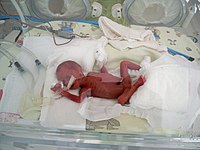
Photo from wikipedia
While the effects of ambient pollutants on adverse perinatal outcomes have been studied, most studies have focused on preterm birth, stillbirth, and low birthweight. Few studies have examined the effects… Click to show full abstract
While the effects of ambient pollutants on adverse perinatal outcomes have been studied, most studies have focused on preterm birth, stillbirth, and low birthweight. Few studies have examined the effects of ambient pollutants on prelabor rupture of membranes (PROM). This study was designed to explore the acute effects of ambient pollutants on both term PROM (TPROM) and preterm PROM (PPROM). We enrolled pregnant women receiving antenatal care between October 2013 and December 2019 at the International Peace Maternity and Child Health Hospital (IPMCHH). The effects of ambient pollutants (including PM2.5, PM10, SO2, CO, NO2, and 8-h O3) on TPROM and PPROM were estimated using generalized additive models (GAMs). Exposure-response relationship curves were also evaluated using GAMs after adjustment for confounding factors. Potential lagged effects were examined using various lag models. The data of 100,200 pregnant women who delivered at IPMCHH were analyzed. The fitted spline curves for PPROM were similar to the temporal trends of PM2.5, PM10, SO2, CO and NO2 but not O3, while those for TPROM were different from the temporal trends of all six air pollutants. An increased risk of PPROM was associated with increased concentrations of PM2.5, PM10, SO2 and CO on lag days 2 and 3, while no association was found between PPROM and daily concentration of O3. After adjustment for confounding factors, there was a shift in the exposure-response curves, indicating associations between PPROM and PM2.5, PM10, SO2, and CO on lag days 2-3. Interaction effects of PM2.5, PM10, SO2, and CO were also found to increase the risk of PPROM. In conclusion, acute exposures to six critical air pollutants were not associated with an increased risk of TPROM; however, PM2.5, PM10, SO2, and CO were found to interact, increasing the risk for PPROM on lag days 2 and 3.
Journal Title: Environmental pollution
Year Published: 2021
Link to full text (if available)
Share on Social Media: Sign Up to like & get
recommendations!